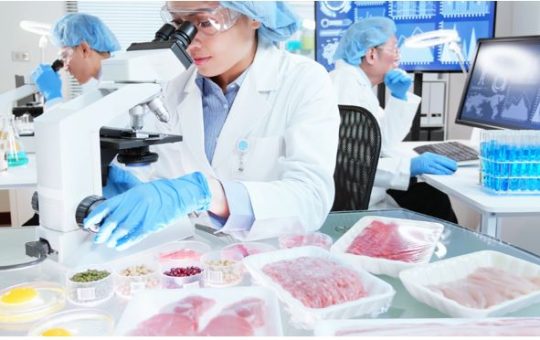
Level 4 Award in Food Safety Management for Manufacturing
Food Safety Management for Manufacturing
Course Overview
The Food Safety Management for Manufacturing course is designed for professionals working in food manufacturing, processing, and packaging environments. This advanced course provides the knowledge and skills needed to manage food safety systems, assess risks, and ensure the highest standards of hygiene, quality, and compliance in food production. The course focuses on the implementation of food safety management systems (FSMS), Hazard Analysis Critical Control Point (HACCP), and regulatory requirements in the context of food manufacturing.
Benefits
- In-depth Knowledge: Gain an advanced understanding of food safety principles and regulations specific to manufacturing settings.
- Regulatory Compliance: Learn how to navigate national and international food safety laws and ensure compliance in manufacturing processes.
- Improved Risk Management: Develop the ability to conduct risk assessments and implement effective control measures to prevent foodborne illness.
- Enhanced Management Skills: Learn how to supervise food safety programs and train employees to ensure consistent safety practices.
- Career Opportunities: Open doors to senior-level positions in food safety management, quality assurance, and compliance.
Learning Outcomes
Upon completing the course, learners will be able to:
- Understand the principles of food safety management and its importance in the manufacturing sector.
- Develop and implement food safety management systems (FSMS) in manufacturing processes.
- Apply the principles of HACCP to identify and control hazards in food production.
- Conduct thorough risk assessments and establish critical control points (CCPs).
- Supervise and train staff in food safety practices, ensuring adherence to hygiene standards.
- Understand the regulatory framework surrounding food safety and maintain compliance with national and international food safety laws.
Study Units
Unit 1: Introduction to Food Safety Management Systems
- Overview of food safety management systems (FSMS) and their application in manufacturing.
- Key components of an FSMS: HACCP, GMP (Good Manufacturing Practices), and SOPs (Standard Operating Procedures).
- The role of food safety management in ensuring product safety and consumer health.
Unit 2: Hazard Analysis and Critical Control Points (HACCP)
- Principles of HACCP and how they apply to food manufacturing.
- Identifying potential hazards: biological, chemical, and physical.
- Establishing Critical Control Points (CCPs) and determining limits for hazard control.
Unit 3: Risk Assessment in Food Manufacturing
- The process of conducting a comprehensive risk assessment in food manufacturing environments.
- Identifying and analyzing risks in food production lines.
- Developing mitigation strategies to control identified risks.
Unit 4: Food Safety Legislation and Compliance
- A detailed overview of food safety laws and regulations (e.g., FDA, EU regulations, Codex Alimentarius).
- Key compliance requirements for food manufacturers, including food labeling, traceability, and recall procedures.
- Understanding regulatory inspections and audits, and how to prepare for them.
Unit 5: Hygiene and Sanitation Standards
- Best practices for maintaining high standards of hygiene and cleanliness in food manufacturing.
- Controlling contamination through effective sanitation programs.
- Personal hygiene practices for workers and the role of hygiene in preventing foodborne illness.
Unit 6: Staff Training and Supervision in Food Safety
- Designing and delivering food safety training programs for manufacturing staff.
- Supervising daily food safety procedures to ensure consistent implementation.
- Motivating staff to follow food safety protocols and maintaining high standards.
Unit 7: Continuous Improvement in Food Safety Management
- Implementing systems for continuous monitoring and improvement of food safety practices.
- Auditing food safety systems and identifying areas for improvement.
- Addressing non-compliance and taking corrective actions.
Career Progression
The Food Safety Management for Manufacturing course prepares individuals for a variety of advanced roles within the food manufacturing industry, including:
- Food Safety Manager: Oversee food safety operations and ensure compliance with all food safety regulations.
- Quality Assurance Manager: Manage quality control systems in manufacturing to ensure that products meet safety and quality standards.
- HACCP Coordinator: Lead the implementation and maintenance of HACCP systems in food manufacturing facilities.
- Regulatory Compliance Officer: Ensure compliance with food safety laws and regulations in manufacturing operations.
- Training Manager: Develop and implement training programs for staff on food safety and hygiene best practices.
This qualification can also lead to more specialized roles or further study in areas such as Food Safety Auditing, Environmental Health, or Public Health, providing opportunities for career advancement at a managerial level.
Our assessment process is designed to ensure every learner achieves the required level of knowledge, skills, and understanding outlined in each course unit.
Purpose of Assessment
Assessment helps measure how well a learner has met the learning outcomes. It ensures consistency, quality, and fairness across all learners.
What Learners Need to Do
Learners must provide clear evidence that shows they have met all the learning outcomes and assessment criteria for each unit. This evidence can take different forms depending on the course and type of learning.
Types of Acceptable Evidence
Assignments, reports, or projects
Worksheets or written tasks
Portfolios of practical work
Answers to oral or written questions
Test or exam papers
Understanding the Structure
Learning outcomes explain what learners should know, understand, or be able to do.
Assessment criteria set the standard learners must meet to achieve each learning outcome.
Assessment Guidelines
All assessment must be authentic, current, and relevant to the unit.
Evidence must match each assessment criterion clearly.
Plagiarism or copied work is not accepted.
All learners must complete assessments within the given timelines.
Where applicable, assessments may be reviewed or verified by internal or external quality assurers.
Full learning outcomes and assessment criteria for each qualification are available from page 8 of the course handbook.
Top Courses
No results found.
Related Courses
Let's Get in touch
Deleting Course Review
Course Access
This course is password protected. To access it please enter your password below:



